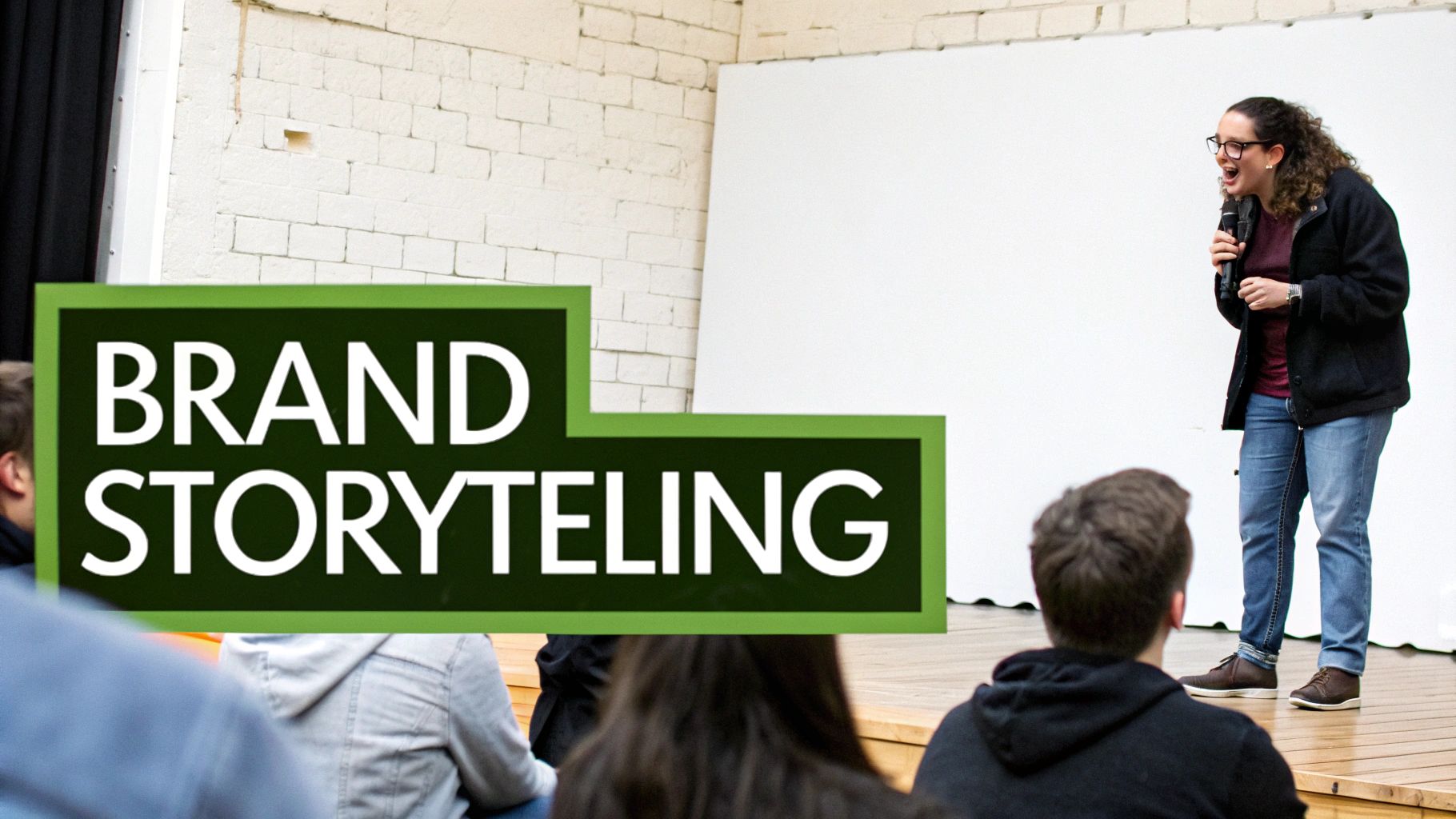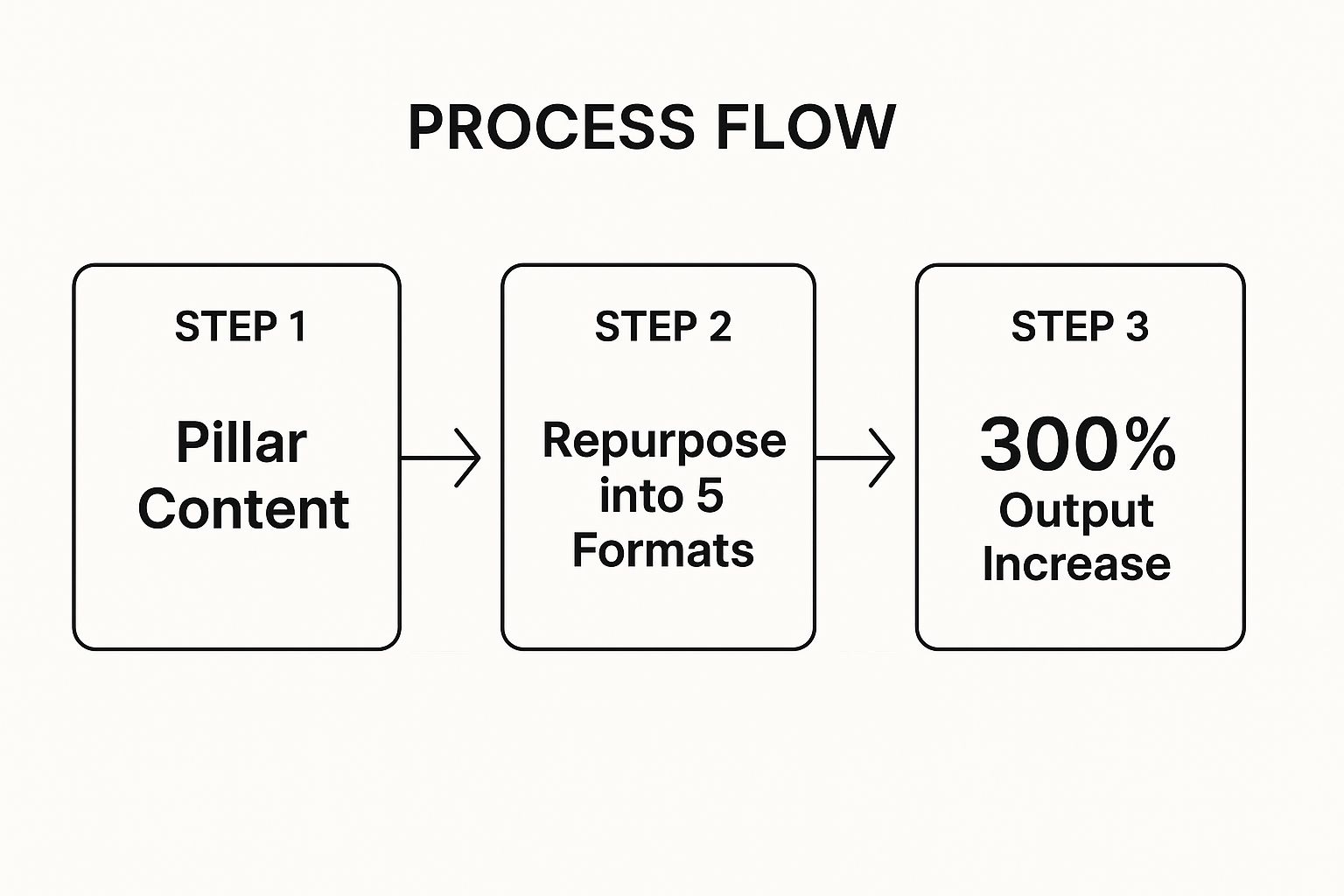Content marketing isn't just about creating more noise; it's about creating value that attracts, engages, and converts. But what does a winning strategy actually look like in the wild? It’s one thing to understand the theory, but seeing how successful brands execute their plans provides a much clearer picture of what works. Instead of abstract concepts, we're dissecting the exact playbooks used by top-tier companies to dominate their markets and build loyal audiences.
This article breaks down seven proven content marketing strategy examples, revealing the specific tactics, the strategic thinking, and the actionable lessons you can apply to your own business today. We will move beyond surface-level descriptions to give you a behind-the-scenes look at the mechanics of great content. You’ll see how brands build unshakable authority with educational content, create viral loops with user-generated stories, and foster deep engagement with interactive experiences.
Each example serves as a blueprint, complete with an analysis of why it succeeded and how you can replicate its core principles. To truly understand how top brands succeed, examining real-world applications is essential. Discover more Content Marketing Strategy Examples: Real-World Inspiration to see how these concepts are put into practice. This collection isn't just for inspiration; it’s a practical guide designed to help you build a content engine that drives tangible results. Let’s dive into the strategies that separate market leaders from the rest.
1. Educational Content Marketing
Educational content marketing is a strategy that focuses on teaching your audience, not just selling to them. Instead of promoting products directly, you provide valuable information that helps potential customers solve problems, learn new skills, or better understand your industry. This approach positions your brand as a trusted expert and builds long-term relationships based on credibility and genuine value.

The core principle, popularized by pioneers like HubSpot and Marcus Sheridan's "They Ask, You Answer" methodology, is simple: by answering your audience's most pressing questions, you attract qualified leads who already see you as a reliable source of information.
Case Study in Focus: HubSpot Academy
HubSpot is a masterclass in educational content marketing. Instead of just writing blog posts about marketing software, they created HubSpot Academy, a free online training platform offering comprehensive courses and certifications in marketing, sales, and customer service.
Strategic Insight: HubSpot didn't just create content; they built an entire educational ecosystem. By offering free, high-value certifications, they attract their ideal audience (aspiring and current marketers) and familiarize them with HubSpot's methodologies and tools, creating a natural pathway to becoming a customer.
This strategy achieves several key goals:
- Builds Authority: They are the go-to resource for digital marketing education.
- Generates Leads: Users sign up for courses, providing valuable lead information.
- Drives Product Adoption: The courses naturally integrate and teach how to use HubSpot's software effectively.
How to Implement This Strategy
To replicate this powerful content marketing strategy example, you don't need to build a full-fledged academy. You can start small and scale your efforts.
- Identify Audience Pain Points: Use tools like AnswerThePublic, check competitor FAQs, and listen to your sales team's conversations. What questions do your customers really ask?
- Develop Content Pillars: Group these questions into core topics related to your expertise. A cybersecurity firm might create pillars around "data privacy," "phishing prevention," and "network security."
- Create Actionable Content: Produce detailed guides, how-to videos, checklists, or webinars for each pillar. Every piece should offer a clear solution or next step. For example, Buffer's transparent blog posts and social media guides provide immediate value to marketers.
- Repurpose and Distribute: Turn a comprehensive blog post into a video tutorial, an infographic, a podcast episode, and a series of social media tips. This maximizes your reach and caters to different learning preferences.
This educational approach is highly effective for businesses with a complex product, a longer sales cycle, or those targeting an audience that values expertise and trust above all else. By teaching first, you earn the right to sell later.
2. Storytelling Marketing
Storytelling marketing is a strategy that uses narrative to connect with an audience on an emotional level. Instead of listing product features or benefits, this approach wraps the brand’s message in a compelling story, making it more memorable, relatable, and human. It transforms a marketing message from a simple transaction into a shared experience.

The core principle, championed by brands like Nike and authors like Seth Godin, is that people don't buy what you do; they buy why you do it. Stories are the most powerful way to communicate that "why," building a brand identity that audiences want to be a part of.
Case Study in Focus: Airbnb
Airbnb is a phenomenal example of storytelling in action. Their entire brand is built not on renting properties but on the idea of belonging anywhere. They achieve this by consistently sharing stories from their community of hosts and guests, turning users into the heroes of the brand narrative.
Strategic Insight: Airbnb puts the customer at the center of every story. Their marketing isn't about their platform's features; it's about the unique human connections and experiences the platform facilitates. This makes the brand feel authentic and community-driven, not corporate.
This narrative-first strategy accomplishes several key objectives:
- Builds Emotional Connection: Stories of travel, community, and belonging resonate far more deeply than ads about lodging.
- Drives Trust: Real user stories act as powerful social proof, showcasing authentic experiences and building credibility.
- Creates a Brand Movement: It elevates Airbnb from a service to a lifestyle choice centered on connection and exploration.
How to Implement This Strategy
You don't need a Hollywood budget to leverage storytelling. This powerful content marketing strategy example can be adapted for any business by focusing on authenticity and human connection.
- Find Your Core Narrative: What is your brand's "why"? Is it to solve a common frustration, empower a community, or challenge the status quo? Define the central theme of your story.
- Make the Customer the Hero: Shift the focus from your brand to your customers. Use testimonials, case studies, and user-generated content to tell their stories. How has your product or service helped them overcome a challenge or achieve a goal?
- Use a Simple Story Arc: A great story needs a beginning (the problem), a middle (the struggle or journey), and an end (the resolution or transformation). Frame your customer stories within this classic hero’s journey structure.
- Leverage Visual Storytelling: Use powerful images, short videos, and customer photos to make your narratives more immersive and emotionally impactful. A single photo can often tell a more compelling story than a block of text.
Storytelling is most effective for brands that want to build a strong community, differentiate themselves in a crowded market, or sell a product tied to emotion and identity. By telling stories, you invite customers to be part of something bigger than just a purchase.
3. User-Generated Content (UGC) Strategy
A User-Generated Content (UGC) strategy shifts the role of content creator from your brand to your audience. Instead of producing all your marketing materials in-house, you encourage and leverage photos, videos, reviews, and testimonials created by your actual customers. This approach builds powerful social proof, fosters a sense of community, and provides a stream of authentic, relatable content.
The underlying principle is that people trust people more than they trust brands. A recommendation or a product feature from a peer feels more genuine than a polished advertisement. By showcasing real customers using and loving your products, you build credibility and relatability at scale.
Case Study in Focus: GoPro
GoPro is a prime example of a brand built on the back of its users' creativity. The company sells action cameras, but what it truly markets are the incredible experiences its customers capture. GoPro’s social media feeds and marketing campaigns are dominated by breathtaking videos and photos submitted by users from around the world.
Strategic Insight: GoPro transformed its customers from passive consumers into active brand storytellers. By creating channels like the GoPro Awards, they incentivized high-quality submissions, ensuring a constant flow of epic, authentic marketing content at a fraction of the traditional cost.
This strategy accomplishes several key objectives:
- Provides Social Proof: Every video is a testament to the camera's quality and durability.
- Builds Community: It unites a global community of adventurers and creators around the brand.
- Fuels Content Engine: GoPro gets an endless supply of diverse, high-energy marketing assets.
How to Implement This Strategy
You don't need a product designed for extreme sports to leverage this powerful content marketing strategy example. Any brand can cultivate a community of creators.
- Create a Clear Call-to-Action: Launch a campaign with a unique, memorable, and branded hashtag. Starbucks' annual #RedCupContest is a perfect example of how to generate seasonal buzz and content.
- Offer an Incentive: Encourage participation by offering rewards. This can range from a simple feature on your official social media pages to prizes, discounts, or cash rewards like GoPro does.
- Engage and Amplify: Actively monitor your hashtag, like and comment on submissions, and ask for permission to reshare the best content. Featuring a customer's post is a powerful form of recognition that encourages others to participate.
- Integrate UGC Everywhere: Don't limit UGC to social media. Use customer photos on product pages, embed positive video reviews on your homepage, and include testimonials in your email newsletters. For more inspiration, you can learn about successful social media strategies that leverage UGC on softriver.co.
This UGC approach is incredibly effective for consumer brands, especially in visually-driven industries like fashion, travel, and food. It turns your customer base into an enthusiastic, authentic, and highly effective marketing team.
4. Interactive Content Marketing
Interactive content marketing is a strategy that moves beyond passive consumption, requiring active participation from the audience. Instead of just reading or watching, users engage with quizzes, polls, calculators, or assessments. This two-way exchange makes the experience more memorable, personal, and valuable for both the user and the brand.

This approach turns content into a dynamic experience. By providing utility (like a calculator) or entertainment (like a quiz), brands can capture attention in a crowded digital landscape, generate highly qualified leads, and gather valuable first-party data directly from their audience.
Case Study in Focus: BuzzFeed's Quizzes
While many companies use interactive tools, BuzzFeed popularized this strategy by turning simple personality quizzes into a viral phenomenon. Their quizzes, like "What City Should You Actually Live In?", are designed for maximum shareability, tapping into users' desires for self-discovery and social connection.
Strategic Insight: BuzzFeed's genius wasn't just creating quizzes; it was engineering them for social sharing. The results are positive, easily digestible, and give users a "badge" to share with their networks, turning every participant into a potential brand ambassador.
This viral loop achieves several key business goals:
- Massive Engagement: Quizzes generate significantly higher engagement rates than static content.
- Audience Data: Each answer provides valuable psychographic data about their audience's preferences and personality traits.
- Brand Awareness: The widespread sharing of quiz results keeps the BuzzFeed brand constantly visible across social media platforms.
How to Implement This Strategy
You don't need BuzzFeed's scale to leverage this powerful content marketing strategy example. Interactive content can be applied to almost any industry to attract and convert customers.
- Align with a Goal: Start with a clear objective. Do you want to generate leads, segment your audience, or educate customers? A B2B SaaS company might create an "ROI Calculator," while an e-commerce brand could build a "Style Finder" quiz.
- Provide Instant Value: The user's payoff for participating must be immediate and worthwhile. A calculator should provide a clear, useful number. A quiz should deliver an insightful or entertaining result that the user feels compelled to share.
- Keep it Simple and Mobile-First: Interactive experiences should be intuitive, fast, and work flawlessly on mobile devices. Avoid complex interfaces or asking for too much information at once. The easier it is to complete, the higher the engagement.
- Gate Results (Strategically): Ask for an email address to deliver the results. This simple exchange turns an engaged user into a valuable lead. Tools like Outgrow or Typeform make it easy to create and embed these interactive experiences on your website.
This strategy is particularly effective for brands looking to cut through digital noise, increase user time-on-site, and generate a trove of useful data to personalize future marketing efforts.
5. Thought Leadership Content
Thought leadership content is a strategy that positions a brand or its key individuals as authoritative experts and visionaries in their field. Instead of focusing on product features, it involves sharing unique insights, forward-thinking perspectives, and in-depth analysis to shape industry conversations and build a reputation for expertise. This approach builds immense trust and credibility, attracting an audience that values deep knowledge and innovation.
The core principle is to go beyond simply answering questions and start asking new ones. Thought leaders like Seth Godin and Simon Sinek don't just explain how things are; they challenge the status quo and offer a new way of thinking, making their content indispensable for those looking to stay ahead.
Case Study in Focus: Gary Vaynerchuk
Gary Vaynerchuk (GaryVee) is a prime example of personal brand thought leadership executed at scale. He has built a media empire by relentlessly sharing his unfiltered opinions, predictions, and strategic advice on digital marketing, entrepreneurship, and social media trends through his company, VaynerMedia.
Strategic Insight: Vaynerchuk's strategy is built on a "document, don't create" philosophy. He shares his daily business life, including his successes, failures, and raw insights, across multiple platforms. This prolific and authentic approach makes his thought leadership feel accessible and constantly relevant.
This strategy accomplishes several key goals:
- Builds a Loyal Community: His audience feels a direct connection to him, trusting his advice because they see him live it.
- Generates Inbound Business: Companies seek out VaynerMedia specifically because they want access to his forward-thinking marketing approach.
- Defines the Industry: His perspectives on new platforms and consumer attention often set the agenda for the entire marketing industry.
How to Implement This Strategy
Becoming a thought leader requires more than just expertise; it requires a unique point of view and a commitment to sharing it consistently.
- Define Your Niche and Angle: Don't just talk about "marketing." Focus on a specific area like "B2B marketing for SaaS startups" or "sustainable e-commerce." What is your unique, even controversial, take on this topic?
- Develop a Core Thesis: What is the central idea you want to be known for? For Reid Hoffman, it's "blitzscaling." For Simon Sinek, it's "Start with Why." Formulate your own core message.
- Create Pillar Content: Publish your ideas in a substantial format, such as a keynote speech, a detailed whitepaper, a research report, or a book. This becomes the cornerstone of your thought leadership.
- Distribute and Engage Widely: Atomize your pillar content into blog posts, LinkedIn articles, short-form videos, and podcast clips. More importantly, engage in industry debates, comment on other leaders' posts, and participate in conversations to amplify your perspective.
This content marketing strategy example is ideal for B2B companies, consultancies, and service-based businesses where expertise and trust are the primary drivers of sales. It's a long-term play that transforms your brand from just another option into the definitive authority.
6. Video Content Marketing
Video content marketing is a multimedia strategy that leverages video formats to engage, entertain, and educate an audience. Instead of relying solely on text or images, this approach uses the power of visual storytelling to capture attention, demonstrate value, and build a more personal connection with viewers across various platforms.
The core principle behind this strategy, popularized by brands like Red Bull and viral sensations like Dollar Shave Club, is to communicate messages more effectively and memorably. Video excels at simplifying complex ideas, showcasing product benefits, and evoking emotion, making it a highly versatile tool in any content arsenal.
Case Study in Focus: Blendtec's "Will It Blend?"
Blendtec, a manufacturer of high-end blenders, faced a common challenge: how to demonstrate the superior power and durability of their product in an overcrowded market. Their answer was the "Will It Blend?" series on YouTube, where they attempted to blend everything from iPhones and golf balls to glow sticks.
Strategic Insight: Blendtec transformed a simple product demonstration into a wildly entertaining and shareable content series. Instead of just saying their blenders were powerful, they proved it in the most extreme and unexpected way possible, creating a viral sensation that was pure marketing genius.
This strategy accomplished several key objectives:
- Builds Massive Brand Awareness: The videos went viral, earning millions of views and putting Blendtec on the map.
- Demonstrates Product Value: It provided undeniable, memorable proof of the blender's power and quality.
- Creates Entertainment: The content was so fun to watch that people shared it willingly, turning viewers into brand evangelists.
How to Implement This Strategy
You don't need a Hollywood budget to succeed with this content marketing strategy example. With modern smartphones and accessible editing software, any business can start creating compelling video content.
- Define Your Video's Purpose: What is the goal? Is it to educate (how-to tutorials), entertain (like Blendtec), or build trust (customer testimonials)? A clear objective will guide your content's direction.
- Hook Viewers Immediately: The first 3-5 seconds are critical. Start with a compelling question, a surprising visual, or a bold statement to capture attention before viewers scroll away.
- Optimize for Each Platform: A 10-minute horizontal video for YouTube won't work as a 30-second vertical TikTok or Reel. Tailor the length, dimensions, and style for each platform you use. Don't forget to include captions for accessibility and silent viewing.
- Repurpose and Distribute Widely: Turn a long-form webinar into short, shareable clips for social media. Convert a video tutorial into a blog post with embedded clips. As technology advances, understanding why video content marketing is so important in the age of AI becomes even more crucial for maximizing your content's impact.
This approach is highly effective for brands that want to demonstrate a product's features, simplify a complex service, or build a strong, personality-driven brand. To get a better grasp of how this fits into a larger plan, you can explore various digital marketing strategy frameworks.
7. Content Repurposing Strategy
A content repurposing strategy is an efficient approach that focuses on maximizing the value of your existing content. Instead of constantly creating new material from scratch, you adapt, atomize, and reformat high-performing "pillar" content for different platforms and audiences. This extends the lifespan of your best work, reaches new segments, and significantly improves the ROI on your initial content creation investment.
The core principle, championed by figures like Gary Vaynerchuk, is to work smarter, not harder. By taking one substantial piece of content, such as a keynote speech or a detailed research report, you can break it down into dozens of smaller assets, each tailored to a specific channel's strengths.
Case Study in Focus: Gary Vaynerchuk's Content Model
Gary Vaynerchuk is the definitive master of content repurposing. His team has systemized a model that turns a single long-form piece of content, like a keynote speech or a podcast episode, into a massive volume of social media posts, blog articles, and short-form videos. This "reverse pyramid" model is a cornerstone of his personal brand's omnipresence.
Strategic Insight: Vaynerchuk’s strategy is built on the idea of creating a single, high-value "pillar" piece of content and then atomizing it into micro-content. This allows him to maintain a high-frequency posting schedule across all platforms without sacrificing the depth and quality of his core message.
This strategy achieves several powerful goals:
- Maximizes Reach: Different people prefer different content formats; this model ensures he connects with them on their preferred platform.
- Ensures Consistency: His core messages are reinforced across all channels, building a strong, cohesive brand identity.
- Boosts Efficiency: It dramatically reduces the time and resources needed to maintain an active presence everywhere online.
The following infographic illustrates the powerful output increase that comes from a structured content repurposing workflow.

This simple process flow demonstrates how one core asset can be multiplied to triple your content output with minimal extra effort.
How to Implement This Strategy
Adopting this content marketing strategy example doesn't require a large team; it just requires a systematic approach. By planning for repurposing from the start, you can build an efficient content engine.
- Identify Your Pillar Content: Start with your most valuable, comprehensive assets. This could be a webinar, an in-depth guide, a research report, or a long-form video interview.
- Atomize the Core Message: Break down the pillar content into its key takeaways, quotes, statistics, and individual concepts. Each of these can become a standalone piece of micro-content.
- Adapt for Each Platform: Reformat the micro-content for different channels. Turn a key stat into a Twitter post, a powerful quote into an Instagram graphic, a short segment into a TikTok video, and a detailed section into a blog post.
- Create a Workflow: Use a content calendar to plan your repurposing schedule. Integrating this process is a key part of developing a marketing plan that actually works and ensures you get the most out of every asset you create.
This strategy is perfect for brands that want to establish authority and maintain a consistent presence across multiple channels without burning out their content creation team. It’s about creating once and distributing forever.
Content Marketing Strategy Comparison: 7 Key Examples
From Examples to Execution: Building Your Winning Strategy
We've journeyed through seven powerful and diverse content marketing strategy examples, from HubSpot's educational empire to GoPro's user-generated content machine. Each case study, whether focused on storytelling, thought leadership, or interactive experiences, reveals a core truth: successful content marketing is never about just selling. It's about serving.
The common thread weaving through every successful brand we analyzed is a relentless commitment to providing genuine value. They don't just interrupt their audience; they attract, engage, and empower them. They understand that a transactional relationship is fleeting, but a relationship built on trust, education, and shared experience creates loyal advocates for life.
Key Takeaways from These Real-World Examples
As you move from inspiration to implementation, it's crucial to distill the core lessons from these leading brands. While their tactics differed, their foundational principles were remarkably similar.
Here are the most important takeaways to guide your own efforts:
- Audience-Centricity is Non-Negotiable: Every winning strategy began with a deep, almost obsessive, understanding of the target audience. They knew their pain points, their aspirations, their questions, and the platforms where they spent their time. Your strategy must start here, too.
- Consistency Builds Empires: Red Bull didn't become a media powerhouse overnight, and Ahrefs didn't build its SEO authority with a handful of blog posts. Success comes from a consistent, long-term commitment to a chosen strategy, building momentum and brand recognition over time.
- Value is the Ultimate Currency: Whether it was a practical tutorial, an inspiring story, or an interactive tool, every piece of content provided clear value. Before you hit "publish," always ask yourself: "How does this help, educate, or entertain my audience?"
- Authenticity Creates Connection: From Glossier’s community-driven approach to Patagonia’s mission-led storytelling, authenticity shines through. Modern consumers can spot a sales pitch a mile away. A genuine brand voice and a clear "why" are your greatest assets.
Your Actionable Next Steps
Feeling inspired is one thing; taking action is another. It’s easy to look at these massive content marketing strategy examples and feel overwhelmed. But you don't need a GoPro-sized budget to start. You just need a clear plan.
Use this simple framework to get started:
- Define Your Foundation: Before you write a single word, solidify your brand identity. What do you stand for? What is your unique voice? A strong brand is the bedrock of a coherent content strategy.
- Choose Your Core Strategy: You can't be everything to everyone. Review the seven strategies we covered. Which one aligns best with your brand's strengths, your team's skills, and your audience's needs? Pick one to master first.
- Start Small and Scale: You don't need to launch a blog, a podcast, and a YouTube channel all at once. Choose one primary channel and one content format. Focus on doing it exceptionally well and creating a repeatable process.
- Measure and Adapt: Track your key metrics. Are you getting traffic? Are you generating leads? Is your audience engaged? Use this data not to judge success or failure, but to learn, iterate, and refine your approach.
Ultimately, the goal is not to copy these brands, but to learn from their strategic thinking. They succeeded because they carved out a unique space by serving their audience in a way no one else could. Your mission is to find that same intersection between what your audience needs and what your brand can uniquely provide. That is where your winning content strategy lives.
A powerful content strategy begins with a powerful brand identity. If you're building from the ground up or refining your market position, the clarity and credibility of a professional brand are essential. Let the team at Softriver help you build the foundational brand identity you need to execute these strategies with confidence and authority.







